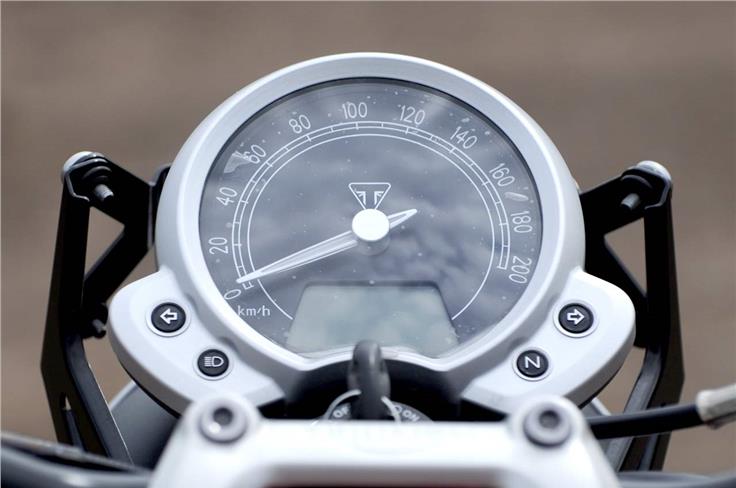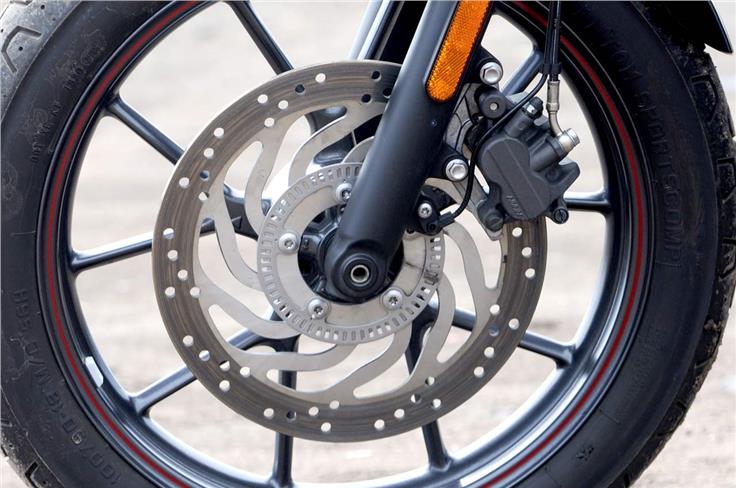Images
Triumph Street Twin vs Ducati Scrambler comparison photo gallery

Ducati’s engineers have repurposed the 803cc air-cooled 4-valve L-twin motor from the Monster 795/796 and fiddled around with it until it suited the Scrambler’s purpose.

Scrambler gets an all-digital, single-pod instrument cluster which looks great, but can get a little tricky to read at times and lacks a gear position indicator.

The Street Twin’s instrument cluster gets a big analogue speedometer along with a small digital multi-function display, but lacks a tachometer.

Nestled in the Triumph Street Twin’s dual-cradle frame is an all-new 8-valve, 900cc parallel twin motor that now gets liquid cooling.

Drop the anchors at 80kph, and the 310mm/255mm front/rear semi-floating discs bring the Street Twin to a halt in a fairly long 35.4 metres.

The Street Twin’s ultra-low seat height of a mere 750mm is welcoming to even the shortest of riders from the get-go.

The Street Twin is supposed to be a standard, road-going motorcycle while the Scrambler feels like it was designed to handle a multitude of surfaces.

When it comes to outright acceleration, the Scrambler has the Street Twin beat, making the dash from nought to 100kph in just 5.03 seconds as compared to 6.14 seconds for the Triumph.

The Street Twin simply does not have the performance and go-anywhere ability of the Scrambler, while the Scrambler lacks the refinement and relaxed riding experience of the Street Twin.

Both bikes are modern interpretations of designs from the early 1960s and represent a distinct shift away from the highly specialised motorcycles that you see today.

Not only does the Scrambler rock a larger 330mm disc at the front, it also gets a 4-pot radially mounted Brembo Monobloc caliper.

While the Scrambler’s seat is quite soft, its shape is rather odd and it can make even the shortest rides out of the city feel like you’re participating in a Bun Burner challenge.

Ducati’s engineers have repurposed the 803cc air-cooled 4-valve L-twin motor from the Monster 795/796 and fiddled around with it until it suited the Scrambler’s purpose.

Scrambler gets an all-digital, single-pod instrument cluster which looks great, but can get a little tricky to read at times and lacks a gear position indicator.

The Street Twin’s instrument cluster gets a big analogue speedometer along with a small digital multi-function display, but lacks a tachometer.

Nestled in the Triumph Street Twin’s dual-cradle frame is an all-new 8-valve, 900cc parallel twin motor that now gets liquid cooling.

Drop the anchors at 80kph, and the 310mm/255mm front/rear semi-floating discs bring the Street Twin to a halt in a fairly long 35.4 metres.

The Street Twin’s ultra-low seat height of a mere 750mm is welcoming to even the shortest of riders from the get-go.

The Street Twin is supposed to be a standard, road-going motorcycle while the Scrambler feels like it was designed to handle a multitude of surfaces.

When it comes to outright acceleration, the Scrambler has the Street Twin beat, making the dash from nought to 100kph in just 5.03 seconds as compared to 6.14 seconds for the Triumph.

The Street Twin simply does not have the performance and go-anywhere ability of the Scrambler, while the Scrambler lacks the refinement and relaxed riding experience of the Street Twin.

Both bikes are modern interpretations of designs from the early 1960s and represent a distinct shift away from the highly specialised motorcycles that you see today.

Not only does the Scrambler rock a larger 330mm disc at the front, it also gets a 4-pot radially mounted Brembo Monobloc caliper.

While the Scrambler’s seat is quite soft, its shape is rather odd and it can make even the shortest rides out of the city feel like you’re participating in a Bun Burner challenge.












View the latest photos of Triumph Street Twin vs Ducati Scrambler. Find exclusive photo gallery of both the bikes on Autocar India.















Comments
Member Login
Personal Details
No comments yet. Be the first to comment.